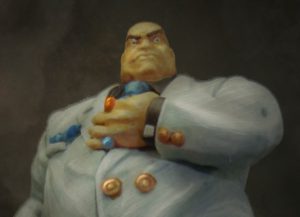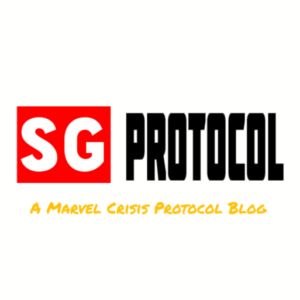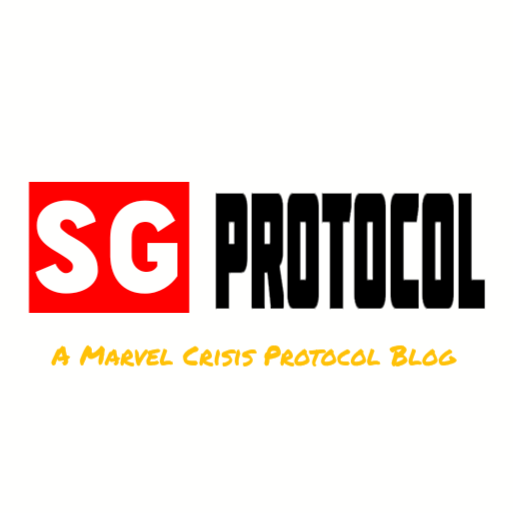
Welcome back to SG Protocol.
Today we continue our how to build a roster series with the topic of leadership types.
One thing we haven’t covered yet that you will encounter often in talk about MCP rosters is the distinction between “scenario” and “attrition” teams. There’s more to it in practice but in very broad sense it’s whether your team is focused on scoring as many VPs as quickly as possible (“scenario”) or try to eliminate enemy models as quickly as possible (“attrition”).
Leadership is only one part of defining your roster to either of those categories (or being a hybrid of both) but with 42 (41 different) leaderships in the game (officially from October 13th) I thought it would be helpful to categorise the different types of them. And it is not as simple as the scenario vs. attrition distinction.
The only leadership in the game that can be called a true scenario leadership is Kingpins:

It directly helps you score VPs from secures which you might not have without the leadership. You typically use it with a characters that are either fast, very resilient or in the best case both. Ulik and Rhino are prime examples of Criminal Syndicate affiliated characters that shine under such a leadership.
Pure attrition leaderships are a bit more common, for example on Shadowlands Daredevil

Cable

Or Green Goblin

These try help you get more damage through in some form of reroll be it your own attacks or in GGs case rerolling success blocks by your opponent. These are leaderships that reward you for taking characters that are good at killing the enemy but can use the help the leadership’s provide to flatten the variance of Marvel dice. Killmonger is a good example here. Also characters like Sabretooth or Angela.
There are also attrition leadership rewarding you with extra damage for getting a certain dice result like M’Baku:

The contrast to attrition leaderships are what I would call anti attrition leaderships. These give you benefits against being attacked or have some other way to keep your models on the table longer. The number one prime example here is Miles Morales:

There aren’t only reroll anti attrition leaderships though. Thor is a good example:

and also Storm:

These are leadership focused on keeping your gals and guys on the table longer. They will often but not always be used by scenario teams for obvious reasons. Keeping your models alive longer means they can score out the game quicker.
Emma Frost also has an anti attrition leadership that overlaps with the next category:
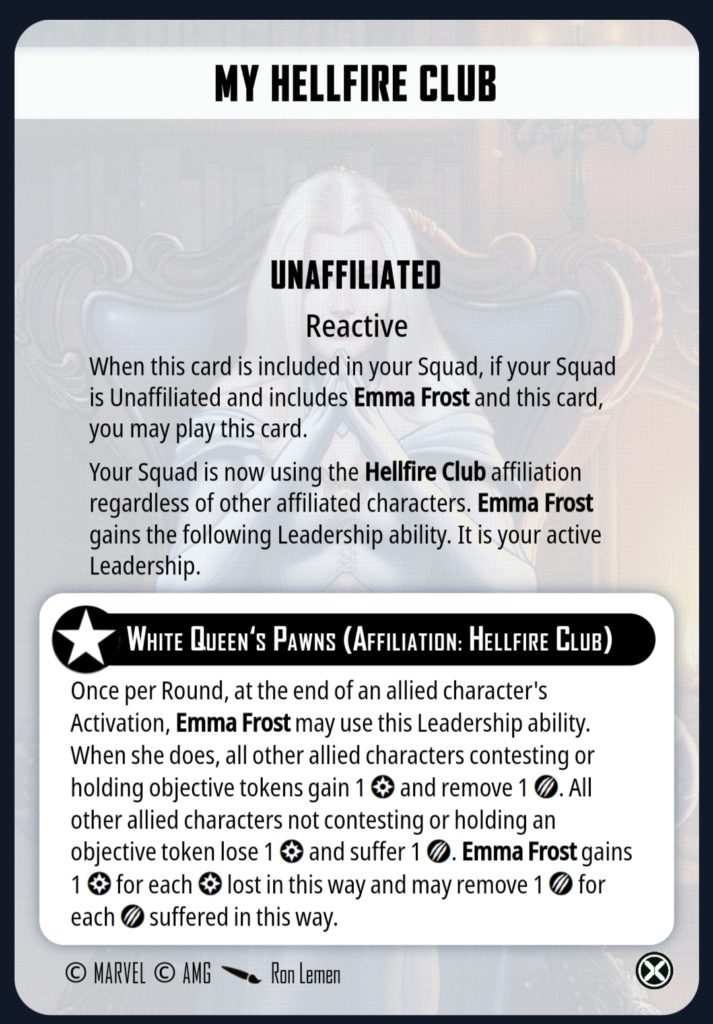
Next up we have what we’ll call the power up leaderships. The gist here is to gain extra power either by being attacked like She-Hulks and new Doc Ocks:


Moving power around from character to character like Black Bolt

Gaining extra power as reward for playing the game with Red Skull, Master of Hydra

Or reducing power cost like original Steve Rogers:

These are all great with characters that can spent their power effectively be it active and reactive superpowers, decent Spender attacks (those that cost power) or both. Prime examples here are characters like Agent Venom and Sabretooth, Apex Predator.
We also have the attrition plus anti attrition dual leaderships. The most classic example of that is Black Panther (and now Invincible Iron Man who has an exact copy of BPs leadership but for Shield):

M.O.D.O.K., Scientist Supreme (commonly called Nudok) also falls into this category:

As does Doctor Strange:

The anti attrition part being the handing out of Hex which helps prevent dice spikes into your characters. Hex also helps all your future attacks against that target until it shakes it or is dazed. The main attrition bonus is to be able to target the enemy models worst defense stat.
Doctor Stranges leadership is a bit more nuanced but in general these hybrid leaderships are there to bring more overall consistency to your squad. Meaning they are less seldom build around leaderships (the premise of the next article in this series) but also basically always useful for every character you put into your roster.
Finally we have the reward leaderships. These don’t give you anything natively but will reward you for doing something or in one case for something done to you.
The most classic example of this is original core set Red Skull:

We then have no less than four different leaderships that reward you for dazing and KO’ing models in Sentinel Prime
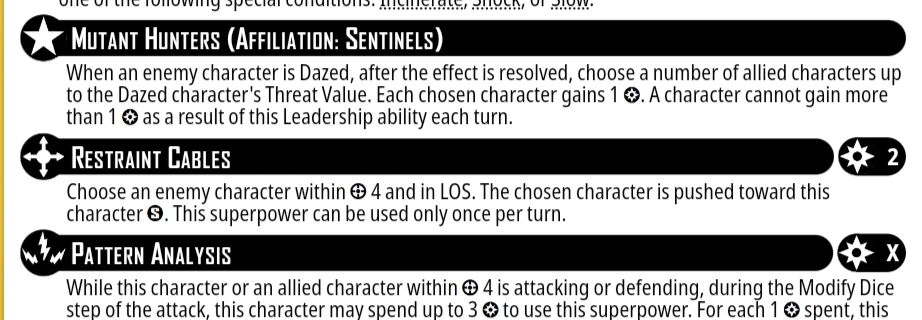
Corvus Glaive
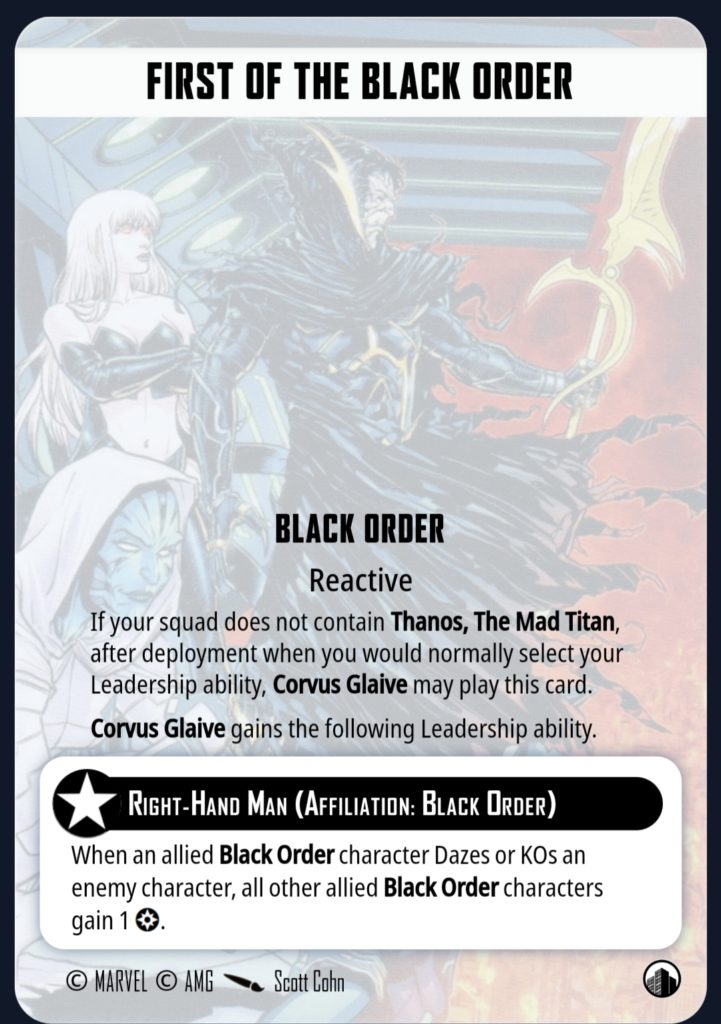
Thanos

(note that this one changes on Thanos injured side)
And finally (the most insane one) Malekith:

None of these actually help you in any way to get the dazes and KO’s so you need models that are natively good at that. Black Order and Cabal each have no real shortage of those but the Sentinels are much better at control and not being controlled than actual attrition, which is why you seldom see the leadership being used. If you can make it work, fantastic 🙂.
Who has the other reward leadership you ask and what must you accomplish to get it? Well it’s the winner of TTS Season 11, piloted by the great Jacob Deaton, Captain America, Sam Wilson:

Sam leadership is fantastic. While you don’t have too much control over it, it punishes your opponent for killing your models, throwing spikes in their wheels of continuing to do so.
So that’s the basic concept of leadership types. Of course there are a tonne we haven’t looked at in detail but all will broadly fall into these categories.
Next time we’ll build a roster using the leadership approach we’ve talked about in the first article of the series.
See you then and cheers from Germany 🍻


